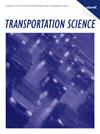动态网络中多式联运路边使用建模
IF 4.8
2区 工程技术
Q1 OPERATIONS RESEARCH & MANAGEMENT SCIENCE
引用次数: 0
摘要
新兴交通技术的激增导致对打车服务、按需配送和微型交通服务的需求大幅增加,从而将路边空间转变为宝贵的公共基础设施,多式联运为此展开了竞争。然而,不同交通模式对路边空间的利用率越来越高,会对社会产生巨大影响,进一步改变人们的出行选择,污染城市环境。如何将与路缘石利用相关的各种行为的时空特征整合到一般动态网络中,并利用多源数据探索移动模式,仍然是一项挑战。为解决这一问题,本研究提出了一个在一般动态网络中模拟多式联运路边使用情况的综合框架。该框架囊括了路由选择、路边空间竞争以及不同路边用户之间的交互效应,并将路边使用的动态变化嵌入到中观动态网络模型中。此外,该框架还提出了一个路边感知的动态起点-终点需求估算框架,通过物理信息数据驱动方法揭示与路边使用相关的网络级时空流动模式。该框架将新出现的现实世界路缘石使用数据与计算图上表示的其他移动数据相结合,可在大规模网络上使用前向后向算法高效求解。该框架在一个小型网络和一个大型真实世界网络上进行了检验。两个网络的估算结果都令人满意和信服,证明了该框架估算多式联运时空路缘使用情况的能力:本文已被 ISTTT25 运输科学特刊接受:本资料基于美国能源部能源效率与可再生能源办公室[DE-EE0009659 奖]支持的工作:在线附录见 https://doi.org/10.1287/trsc.2024.0522 。本文章由计算机程序翻译,如有差异,请以英文原文为准。
Modeling Multimodal Curbside Usage in Dynamic Networks
The proliferation of emerging mobility technology has led to a significant increase in demand for ride-hailing services, on-demand deliveries, and micromobility services, transforming curb spaces into valuable public infrastructure for which multimodal transportation competes. However, the increasing utilization of curbs by different traffic modes has substantial societal impacts, further altering travelers’ choices and polluting the urban environment. Integrating the spatiotemporal characteristics of various behaviors related to curb utilization into general dynamic networks and exploring mobility patterns with multisource data remain a challenge. To address this issue, this study proposes a comprehensive framework of modeling curbside usage by multimodal transportation in a general dynamic network. The framework encapsulates route choices, curb space competition, and interactive effects among different curb users, and it embeds the dynamics of curb usage into a mesoscopic dynamic network model. Furthermore, a curb-aware dynamic origin-destination demand estimation framework is proposed to reveal the network-level spatiotemporal mobility patterns associated with curb usage through a physics-informed data-driven approach. The framework integrates emerging real-world curb use data in conjunction with other mobility data represented on computational graphs, which can be solved efficiently using the forward-backward algorithm on large-scale networks. The framework is examined on a small network as well as a large-scale real-world network. The estimation results on both networks are satisfactory and compelling, demonstrating the capability of the framework to estimate the spatiotemporal curb usage by multimodal transportation.History: This paper has been accepted for the Transportation Science Special Issue on ISTTT25.Funding: This material is based upon work supported by the Office of Energy Efficiency and Renewable Energy, U.S. Department of Energy [Award DE-EE0009659].Supplemental Material: The online appendix is available at https://doi.org/10.1287/trsc.2024.0522 .
求助全文
通过发布文献求助,成功后即可免费获取论文全文。
去求助
来源期刊

Transportation Science
工程技术-运筹学与管理科学
CiteScore
8.30
自引率
10.90%
发文量
111
审稿时长
12 months
期刊介绍:
Transportation Science, published quarterly by INFORMS, is the flagship journal of the Transportation Science and Logistics Society of INFORMS. As the foremost scientific journal in the cross-disciplinary operational research field of transportation analysis, Transportation Science publishes high-quality original contributions and surveys on phenomena associated with all modes of transportation, present and prospective, including mainly all levels of planning, design, economic, operational, and social aspects. Transportation Science focuses primarily on fundamental theories, coupled with observational and experimental studies of transportation and logistics phenomena and processes, mathematical models, advanced methodologies and novel applications in transportation and logistics systems analysis, planning and design. The journal covers a broad range of topics that include vehicular and human traffic flow theories, models and their application to traffic operations and management, strategic, tactical, and operational planning of transportation and logistics systems; performance analysis methods and system design and optimization; theories and analysis methods for network and spatial activity interaction, equilibrium and dynamics; economics of transportation system supply and evaluation; methodologies for analysis of transportation user behavior and the demand for transportation and logistics services.
Transportation Science is international in scope, with editors from nations around the globe. The editorial board reflects the diverse interdisciplinary interests of the transportation science and logistics community, with members that hold primary affiliations in engineering (civil, industrial, and aeronautical), physics, economics, applied mathematics, and business.
 求助内容:
求助内容: 应助结果提醒方式:
应助结果提醒方式:


